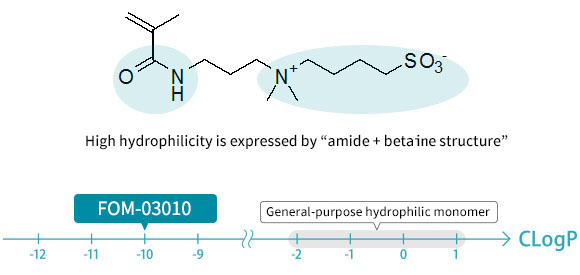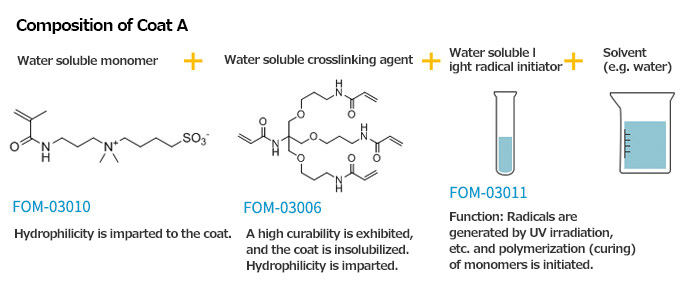FOM-03010
Water soluble monomer

Plastics manufacturing
Photocurable
FOM-03010 is a Fujifilm's unique novel monomer containing a betaine structure and a methacrylamide group that exhibits high hydrophilicity. It is highly hydrophilic and biocompatible as well as stable.

| Chemical name | [3-(Methacryloylamino)propyl]dimethyl(3-sulfobutyl)ammonium hydroxide inner salt |
|---|---|
| CAS RN® | 83623-32-9 |
Physical characteristics
| FOM-03010 | ||
|---|---|---|
| Physical characteristics | Form | Powder |
| Color | White | |
| Odor | Odorless |
|
| Melting point | None | |
Related laws and regulations
| TSCA | Not Listed |
|---|---|
| EINECS | Not Listed |
| REACH | Not Listed |
Characteristics
1) Highly water soluble and hydrophilic
- FOM-03010 dissolves in water at 50 wt% or more. It is easily soluble in solvents such as methanol and ethanol.
- Due to the betaine structure, it exhibits very high hydrophilicity. (CLogP = -10)

Many of the hydrophilic monomers currently on the market have CLogP values of around -2 to +1, which is an index of hydrophilicity/hydrophobicity.
FOM-03010 has a CLogP value of -10 and much higher hydrophilicity than these general-purpose monomers.

Also in the LogD value, which is a hydrophilicity index considering the dissociation of molecules under different pH environments, FOM-03010 shows high hydrophilicity with LogD = -4 (pH = 7).
MPC:2-Methacryloyloxyethyl phosphorylcholine
GLBT:Carboxymethyl betaine monomer
HEMA:2-Hydroxyethyl methacrylate
Solubility in various solvents and monomers
| Solvent/monomer name | Solubility at each solid content concentration (weight%) | |||||||
|---|---|---|---|---|---|---|---|---|
| 0.1 | 0.5 | 1 | 10 | 20 | 30 | 40 | 50 | |
| Water | ◯ | ◯ | ◯ | ◯ | ◯ | ◯ | ◯ | ◯ |
| Methanol | ◯ | ◯ | ◯ | ◯ | ◯ | ◯ | × | - |
| Ethanol | ◯ | ◯ | ◯ | ◯ | × | - | - | - |
| Isopropyl alcohol | ◯ | ◯ | × | - | - | - | - | - |
| Dimethylsulfoxide | ◯ | ◯ | ◯ | ◯ | ◯ | × | - | - |
| Acetone | × | - | - | - | - | - | - | - |
| Ethyl acetate | × | - | - | - | - | - | - | - |
| Dimethylacetamide | × | - | - | - | - | - | - | - |
| 2-Hydroxyethyl methacrylate (HEMA) |
◯ | ◯ | ◯ | ◯ | × | - | - | - |
| N-(2-Hydroxyethyl) acrylamide | ◯ | ◯ | ◯ | ◯ | ◯ | × | - | - |
| N,N-Dimethylacrylamide | ◯ | × | - | - | - | - | - | - |
| 4-Acryloyl morpholine | ◯ | × | - | - | - | - | - | - |
※Measured at liquid temperature of 25°C
※ 🞅: Soluble 🞨: Insoluble -: Not measured
2) Excellent in hydrolysis resistance
- Excellent in hydrolytic resistance in acidic to basic aqueous solutions.
3) Highly biocompatible
- Resistant to cell adhesion and platelet adhesion. *Based on the test by FUJIFILM
Verification of the inhibitory effect of cell adhesion

Applications
Imparting biocompatibility to various products
Examples:Medical devices, materials for analytical instruments, materials for bioengineering
Hydrophilic/antifouling coating
Examples:Separating film, analytical instruments, building materials, water-absorbing materials, fibers, household products, cleaning agents
Water retaining/moisturizing materials
Examples:Additives for cosmetics and toiletry products, civil engineering materials, sanitary goods
Control of hydrophilicity/hydrophobicity of various cured components
Examples:Paint, coating, kneaded and molded products, printing materials, gel, drug formulation materials
Usage example
- A functional coat with a high hydrophilicity can be formed.
- Due to the high water solubility of the monomer and initiator, a coat solution can be prepared using water as a solvent.

Example of composition of Coat A
| Name of raw material | Compounding ratio (wt%) |
| Water soluble crosslinking agent (FOM-03006) | 30 |
|---|---|
| Water soluble monomer (FOM-03010) | 67 |
| Water soluble light radical initiator (FOM-03011) | 3 |
| Methanol | 400 |
Usage example and physical characteristics of Coat A
- Apply to PET substrate, dry (50°C/5 min), and then photocure (3 J/cm2)
※Lamp used: High pressure mercury lamp (Exposure is controlled as UV-A)
| Coats evaluated | Water contact angle (°) |
| PET alone | 75 |
|---|---|
| Coat A | 35 |
| Impregnate Coat A with water and dry | 44 |
In evaluation of wettability by water contact angle showing affinity with water, Coat A exhibits high hydrophilicity with a low contact angle, and maintains the hydrophilicity even when it is re-dried after being impregnated with water.
Contact us for more details.
We are waiting for questions and requests on products.

